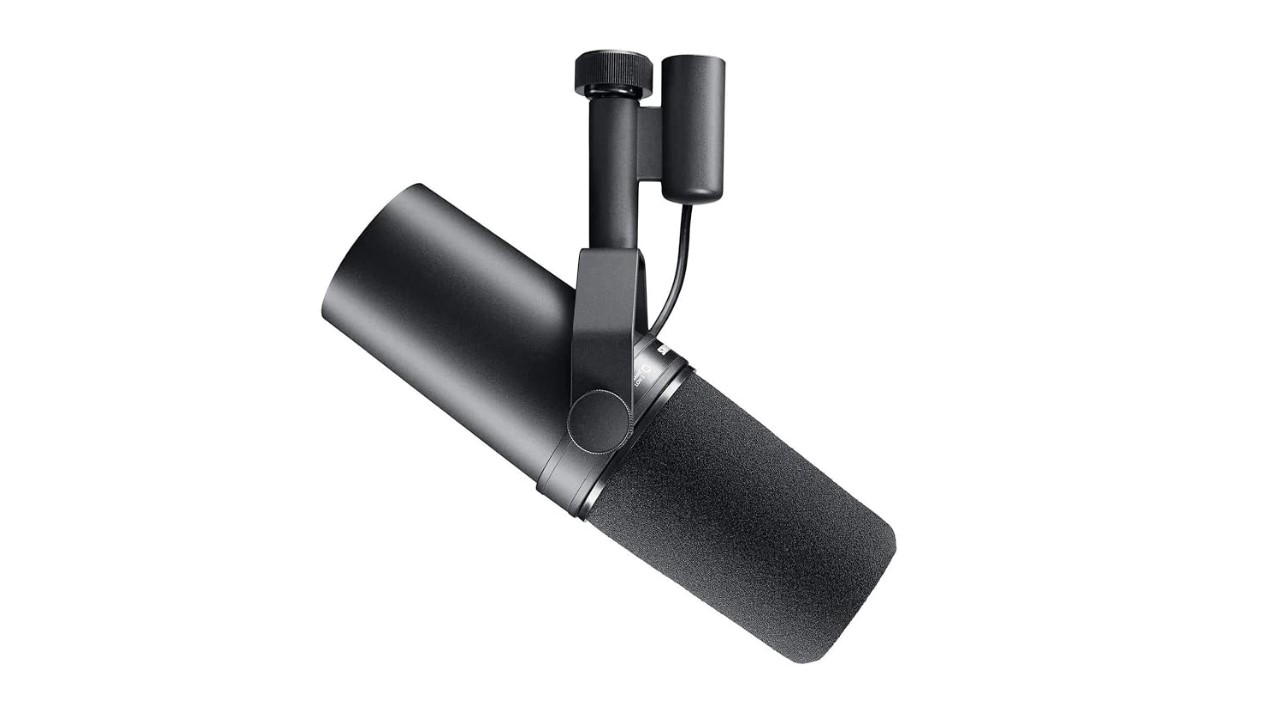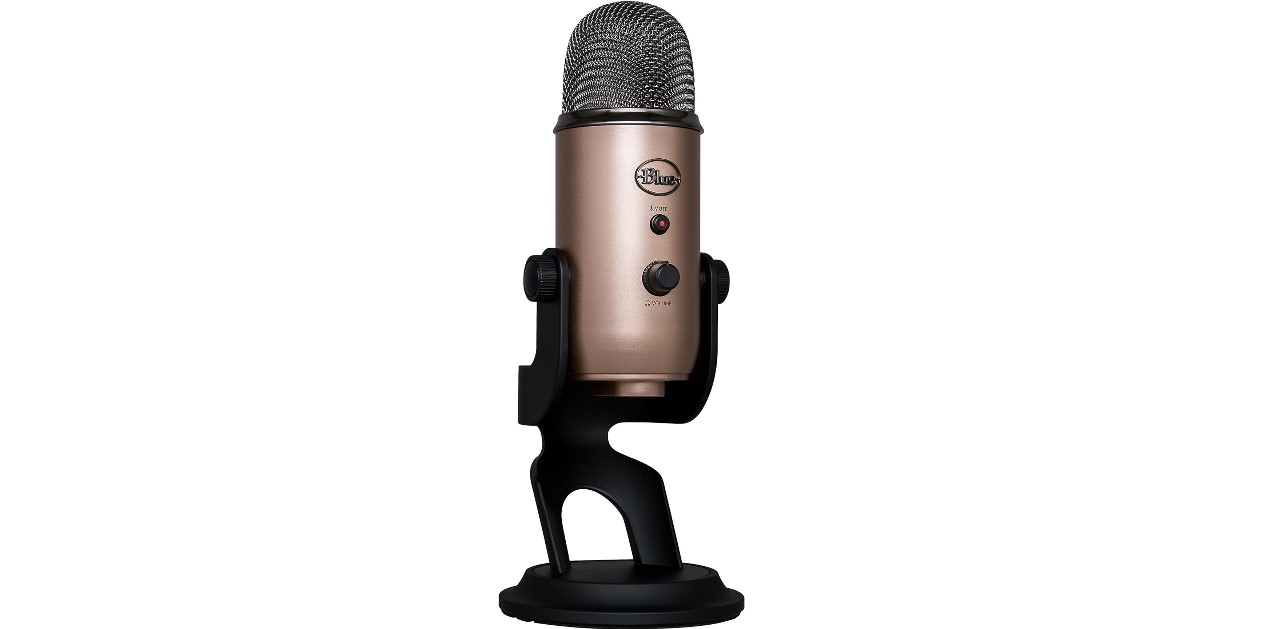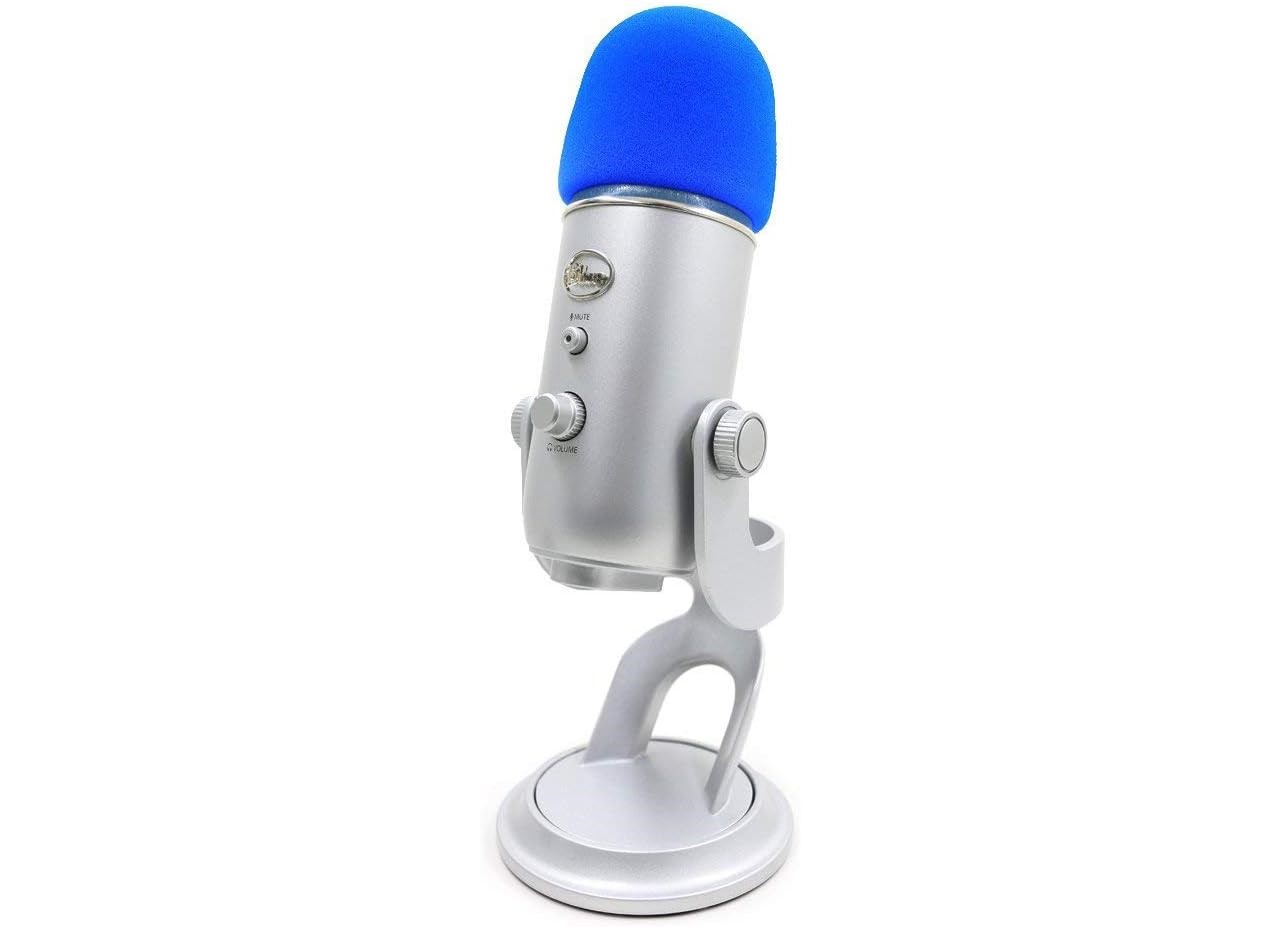When diving into the world of podcasting, streaming, or even music production, the quality of the microphone you choose can make or break your sound. Two of the most talked-about microphones in the industry are the Shure SM7B and the Blue Yeti.
Both have gained a substantial following but for different reasons. This article aims to dissect the nuances, pros, and cons and ultimately help you decide which microphone best suits your needs when comparing Shure and Blue Yeti.
Related: The Best Microphones For Recording in Podcasting
Contents
Shure SM7B vs Blue Yeti: History And Brand Reputation
Every legendary product has a story behind its creation and popularity. In the audio world, brand reputation is often built over years or even decades of consistent performance and innovation. Let’s delve into the historical paths of Shure and Blue.
Shure’s Legacy
Shure Incorporated, with nearly a century under its belt, has been at the forefront of audio innovation. Originating in 1925, the company has consistently delivered microphones that professionals swear by. The SM7B, in particular, is a continuation of this legacy – often seen in radio stations, recording studios, and even gracing the desks of renowned podcasters and voice over artists.
Blue’s Journey
On the other end of the spectrum is Blue Microphones, a younger company established in 1995. Despite its relatively recent entry, Blue quickly rose to prominence with its unique designs and a keen focus on USB mics tailored for the modern creator. The Yeti, one of their flagship products, is a testament to their innovative spirit and commitment to user-friendly solutions.
Shure SM7B vs Blue Yeti: Design And Build Quality
While technical specs and exceptional sound quality are paramount, the design and build quality of a microphone can’t be overlooked. A mic’s build not only determines its durability but also its aesthetic appeal on a desk or studio setup. Let’s dissect the physical attributes of both the SM7B and the Yeti.
Shure SM7B’s Robust Design
The Shure SM7B exudes a sense of professionalism with its sturdy metal construction and dark finish. Its sleek cylindrical shape is unmistakably iconic in the audio world. Designed to withstand the rigors of daily studio use, it offers an integrated air suspension shock isolation system that minimizes mechanical noise transmission.
The foam windscreen that comes with it ensures that plosive sounds are kept at bay, making it an excellent choice for close proximity vocals.
Blue Yeti’s Modern Touch
Blue Yeti, with its standout retro aesthetic, is often the centerpiece of many creators’ setups. The metal grille, combined with a glossy finish available in multiple colors, gives it a distinctive look. While its design is undeniably charming, it’s not just about looks.
The sturdy stand it comes with is versatile, allowing users to adjust the microphone’s angle to their preference. Additionally, its multifaceted design houses multiple capsules inside, aiding in its versatile recording capabilities.
Now, onto the nitty-gritty technical specifications.
Shure SM7B vs Blue Yeti: Technical Specifications
Diving into the technical aspects can provide insights into why a particular microphone sounds the way it does. By understanding the underlying mechanics, one can make an informed decision about which USB microphone or traditional XLR microphone aligns with their recording needs.
Under The Hood Of Shure SM7B

The SM7B cardioid pattern is designed to reject off-axis audio. Image Source.
When one mentions the Shure SM7B, it’s hard not to think about its legendary status in the professional audio realm. This microphone isn’t just revered for its brand name or sleek design but for the intricate engineering that lies beneath its exterior. As we look deeper into its specifications, it becomes evident why this mic has become a staple in countless studios around the world.
The SM7B’s pedigree stems from Shure’s dedication to delivering uncompromising sound quality. This commitment is evident in the microphone’s technical aspects, which are meticulously tailored to cater to voice recordings, from spoken word to vocal performances. Let’s examine the core components that contribute to its acclaimed sound.
Dynamic Microphone Mechanism
The Shure SM7B is a dynamic mic, which means it utilizes a diaphragm/voice coil/magnet assembly. This mechanism gives it the ability to handle extremely high end sound pressure levels without distortion, making it suitable for vocals and loud instruments.
Frequency Range And Polar Patterns
The SM7B boasts a wide range frequency response ranging from 50 Hz to 20,000 Hz, catering to a wide array of audio sources. Its cardioid polar pattern ensures that sound is picked up predominantly from the front, isolating unwanted noise from the back and sides.
Related: How To Set Up Shure SM7B
The Mechanics Of Blue Yeti
The Blue Yeti, with its futuristic and unique design, isn’t just about aesthetics; it’s a testament to Blue’s innovative approach to audio technology. A significant departure from traditional studio microphones, the Yeti was conceptualized with the modern content creator in mind. This perspective is evident when we delve deeper into its technical attributes.
Designed to be versatile, the Yeti brings a fusion of functionality and technology. Its specifications aren’t just numbers on a sheet but are directly linked to its ability to perform in various recording scenarios. From podcasting to music, the Blue Yeti promises adaptability, and much of this promise lies in its technical prowess.
Condenser Microphone Attribute

The Blue Yeti is plug ‘n play on Mac and PC. Image Source.
Unlike the SM7B, the Blue Yeti is a condenser microphone, which requires power (provided by the USB connection) for its internal electronics. This design is known for its sensitivity and ability to capture more detailed sound, making it an excellent choice for capturing nuances in vocals, instruments, and ambient noises.
Selectable Polar Patterns And Capabilities
One of the standout features of the Blue Yeti is its selectable polar patterns: cardioid, bidirectional, omnidirectional, and stereo. This versatility allows users to choose the best pattern for their specified recording situation, be it a solo podcast, an interview, or ambient room sound.
Related: How To Optimize Your Blue Yeti Mic Settings
Shure SM7B vs Blue Yeti: Performance And Sound Quality
Sound quality is the heart of any microphone. It’s where the rubber meets the road. But how do these microphones perform under different scenarios, and what sets them apart in real-world applications?
Shure SM7B In Action
The real world is where a microphone truly earns its stripes. Shure’s SM7B, having carved a niche for itself in professional studios, has countless tales of performance excellence attached to its name. While its technical specifications provide a foundation, the nuances of its sound in practical scenarios truly distinguish it.
Whether it’s the soulful tunes of a vocalist or the analytical discourse of a podcaster, the SM7B ensures that the audio is captured in its purest form. It’s this consistency in delivering high-quality sound across various settings that has cemented its place as a go-to microphone for professionals.
Clarity And Depth In Various Environments
One of the reasons the SM7B is beloved by professionals is its exceptional clarity. Whether it’s capturing the deep tones of a broadcaster’s voice or the intricate details of a vocalist, the SM7B delivers consistent performance. Its wide frequency response ensures that both high and low frequencies are captured with precision.
Feedback and noise suppression
Given its dynamic nature and cardioid pattern, the SM7B inherently rejects ambient noise. Moreover, its air suspension shock isolation system proves pivotal in eliminating mechanical noises. This makes the SM7B a favorite for live recordings where background noise suppression is crucial.
Blue Yeti’s Acoustic Prowess
The Blue Yeti, being a relatively newer entrant compared to the longstanding SM7B, had the challenge of making its mark in a saturated market. However, it did so with aplomb, primarily because of its performance metrics. While its design turned heads, it was the Yeti’s sound quality that truly won hearts.
For a microphone that boasts a range of selectable polar patterns and a condenser build, the Yeti demonstrates remarkable versatility. Be it in the quiet confines of a makeshift home studio or the ambient hum of a living room; the Yeti captures sound with a depth and clarity that’s commendable for its price point.
Versatility In Recording Scenarios
The Blue Yeti shines in scenarios where versatility is key. Whether you’re recording a solo podcast, a multi-person interview, or ambient sounds, the selectable polar patterns allow users to optimize the microphone’s pickup. Its condenser nature means it captures sound with richness and depth.
The Sound Richness And Ambient Noise Capture
The Blue Yeti’s sensitivity allows it to capture the subtleties in voices and instruments, giving recordings a full-bodied sound. However, this sensitivity means that it might pick up more ambient noise than the SM7B, especially in untreated rooms.
Shure SM7B vs Blue Yeti: Features And Usability
Beyond sound quality, the features and usability of a microphone can greatly influence the overall recording experience. Whether it’s the ease of plug-and-play or the adaptability to different setups, these factors can be game-changers.
User-Friendly Nature Of Shure SM7B

Image by Freepik
When professional equipment comes to mind, there’s often a perception of complexity. The Shure SM7B, despite being an industry-standard microphone, challenges this notion. While its prowess lies in delivering studio-quality sound, its user-centric design ensures that even those unfamiliar with professional audio gear can navigate its features with ease.
The SM7B, though stripped down in terms of onboard controls, is built for integration. This means that while it might not have an array of buttons and dials on the mic itself, its true potential is unlocked when paired with mixers, preamps, and audio interfaces. This strategic design choice keeps the microphone’s interface clutter-free while allowing users to tap into advanced settings through their audio setups.
- Onboard controls and adaptability: The SM7B is straightforward in its design, with minimal controls, making it less daunting for new users. Its primary focus is to deliver quality sound without the bells and whistles. However, for those looking to tweak and adapt, external mixers or audio interfaces can be used in conjunction to tailor the sound.
- Integration with audio setups: Being an XLR microphone, the SM7B integrates seamlessly into professional audio setups, offering the flexibility to be paired with high-quality preamps and processors.
Blue Yeti’s Intuitive Design
The modern content creator often juggles multiple roles: writer, editor, host, and sound engineer, to name a few. Recognizing this multitasking nature, Blue designed the Yeti to be intuitive and hassle-free. This microphone isn’t just about capturing good sound; it’s about ensuring that the process to do so is straightforward and efficient.
Right from the unboxing, the Yeti’s user-friendly demeanor shines through. With its plug-and-play functionality, even someone completely new to the world of audio recording can be up and running in minutes. Add to this the onboard controls that allow for real-time adjustments, and you have a microphone that’s as cooperative as it is capable.
- Plug-and-play USB functionality: One of the Blue Yeti’s most praised features is its plug-and-play nature. Simply connect it to a computer via USB, and you’re ready to record. This ease of use is particularly beneficial for beginners or those who want a hassle-free setup.
- Gain control, mute button, and headphone output: The Yeti houses onboard controls, allowing users to adjust the microphone’s gain, mute the sound, and even monitor recordings in real-time via a headphone jack. These features make it a highly user-centric microphone.
Shure SM7B vs Blue Yeti: Pricing And Value For Money

Image by Freepik
Cost is often a decisive factor in any purchase decision. But understanding the value proposition – what you’re getting for your money – can help justify an investment or identify a bargain.
Shure SM7B’s Investment Perspective
In the realm of audio equipment, the adage “you get what you pay for” often rings true. The Shure SM7B, with its professional-grade credentials, commands a premium price. But is this cost justified? To answer this, one must look beyond just the initial price tag and evaluate the long-term value proposition.
The SM7B isn’t merely an expense; it’s an investment. Its rugged build ensures longevity, and its sound quality ensures that your recordings stand out. For professionals who understand the intricacies of sound and the importance of audio quality in content, the SM7B offers returns on investment that go beyond mere monetary calculations.
- Initial cost and long-term value: The Shure SM7B comes with a higher price tag compared to the Blue Yeti, reflecting its professional-grade build and performance. While the initial investment might seem steep, its durability, timeless design, and consistent performance make it a valuable long-term asset for serious creators.
- Target audience and justify the price: Aimed at professionals and serious enthusiasts, the price of the SM7B can be justified by its impeccable sound quality, robust build, and the reputation of the Shure brand.
Blue Yeti’s Budget-Friendly Appeal
For budding creators or hobbyists, the idea of spending a fortune on audio equipment can be daunting. Enter the Blue Yeti: a microphone that promises commendable performance without burning a hole in your pocket. But how does it stack up in terms of value for its relatively modest price?
The Yeti’s charm lies in offering a balance. While it might not match the pinnacle of professional studio microphones in terms of performance, it offers a sound quality that’s more than satisfactory for its price bracket. Moreover, its user-friendly features ensure that even beginners can extract maximum value from their purchase, making it an attractive proposition for those on a budget.
- Accessible pricing for beginners: The Blue Yeti offers a more budget-friendly alternative without compromising too much on sound quality. Its price point makes it accessible to beginners, hobbyists, and those on a tighter budget.
- Comparing cost to performance: When weighing cost against performance, the Blue Yeti offers substantial value. While it might not match the SM7B in certain professional scenarios, it certainly holds its own in many recording situations
Shure SM7B vs Blue Yeti: Pros And Cons
While both microphones have a plethora of admirable qualities, no product is without its downsides. By weighing the strengths against the weaknesses, you can determine which microphone aligns best with your priorities.
Shure SM7B Highlights And Shortcomings
The Shure SM7B has been in the limelight for years, lauded by many professionals across industries. But like any other piece of equipment, it comes with its own set of strengths and weaknesses. Understanding these can help potential buyers align their needs with what the microphone offers.
The SM7B’s strengths are rooted in its legacy of performance and reliability. It’s a microphone that’s seen action in countless recording sessions, from radio stations to global music hits. However, no product is without its critiques. While some of these criticisms might be subjective, understanding both sides of the coin is crucial for an informed purchase decision.
Major Advantages
- Professional-grade sound quality.
- Rugged build designed for longevity.
- Excellent noise and feedback suppression.
- Trusted by industry professionals worldwide.
Potential Drawbacks Or Limitations
- Requires a good quality preamp for best results.
- A higher price point may not be suitable for all budgets.
- Lack of onboard controls might deter some users.
Blue Yeti’s Strengths And Weaknesses
The Blue Yeti, often considered the darling of the modern content creation era, has rapidly amassed a following. Its rise to prominence is a combination of its user-friendly design, sound quality, and pricing. However, as with any product, it’s essential to balance the hype with an objective look at its potential shortcomings.
The Yeti’s selling points are easy to identify. It’s a microphone that’s been crafted with the current generation of podcasters, streamers, and YouTubers in mind. Yet, some purists argue that there are areas where the Yeti could improve. As we explore its strengths and weaknesses, we’ll aim to present a balanced view, helping you decipher whether it’s the right microphone for your needs.
Top-selling Points
- Versatile with selectable polar patterns.
- User-friendly with plug-and-play functionality.
- Onboard controls for real-time adjustments.
- Aesthetically pleasing design with multiple color options.
Areas Of Improvement
- Tends to capture more ambient noise.
- Not as robust as some professional-grade microphones.
- USB connectivity limits integration with some professional audio setups.
FAQs
Which Shure Mic Did Michael Jackson Use?
Michael Jackson, the King of Pop, recorded some of his most iconic tracks using the Shure SM7 microphone, which is a predecessor to the Shure SM7B discussed in this article. His album “Thriller”, which remains one of the best-selling albums of all time, had vocals that were primarily captured using the Shure SM7.
The microphone’s smooth frequency response and ability to handle high sound pressure levels made it a perfect choice for capturing Jackson’s dynamic vocal range.
Why Is The Blue Yeti So Popular Among Podcasters And Streamers?
The Blue Yeti’s rise in popularity among podcasters and streamers can be attributed to several factors:
- Plug-and-play functionality: No need for additional audio interfaces or mixers. Just connect the Yeti to a computer via USB, and you’re set.
- Versatility: With selectable polar patterns, users can easily switch between cardioid, bidirectional, omnidirectional, and stereo modes, making it suitable for various recording scenarios.
- Affordability: For its price point, the Blue Yeti delivers a sound quality that often surpasses other microphones in its range.
- Intuitive controls: Onboard gain control, mute button, and a headphone jack for real-time monitoring simplify the recording process for beginners.
What’s The Primary Difference Between A Dynamic Microphone And A Condenser Microphone?
The main difference lies in their internal mechanisms and how they capture sound:
- Dynamic Microphones (e.g. Shure SM7B): Use a diaphragm/voice coil/magnet assembly that moves within the microphone, generating an electrical current. This makes them less sensitive to subtle sound nuances but more durable and less susceptible to moisture and rough handling.
- Condenser Microphones (e.g. Blue Yeti): Utilize a charged internal electronics system to capture sound. They are more sensitive and can pick up a wider range of frequencies, making them ideal for studio settings. However, they are more fragile and usually require an external power source or battery.
Can The Shure SM7B Be Used Without An External Preamp?
While the Shure SM7B can technically be plugged into any interface or mixer with a standard XLR input, its low output level means that a good amount of clean gain is needed to get the best sound quality. Many audio interfaces might not provide the required gain, leading to a low or noisy signal.
To rectify this, it’s often recommended to use an external preamp or a Cloudlifter to boost the microphone’s signal, ensuring clear and robust audio capture.
Conclusion And Final Thoughts
In the face-off between the Shure SM7B and the Blue Yeti, it’s evident that both microphones cater to slightly different audiences. The Shure SM7B is a powerhouse designed for those who seek professional-quality recordings and are willing to invest in their audio setup. On the other hand, the Blue Yeti offers versatility, user-friendly features, and excellent value for its price, making it ideal for budding creators.
If you’re just starting out or are on a tighter budget, the Blue Yeti provides an excellent balance of quality, versatility, and affordability. Its plug-and-play nature ensures that you can get started immediately without delving into complex setups.
The Shure SM7B is the way to go. Its impeccable sound quality, coupled with its robust design, ensures it stands the test of time and rigorous use. While the initial investment is higher, the returns in terms of audio quality are unmatched.
Having explored both microphones in-depth, it’s clear that neither is objectively ‘better’ than the other; it all boils down to individual needs. If you prioritize ease of use and versatility, the Blue Yeti won’t disappoint. However, if you’re looking to elevate your audio game to professional levels, the Shure SM7B is a worthy investment.



